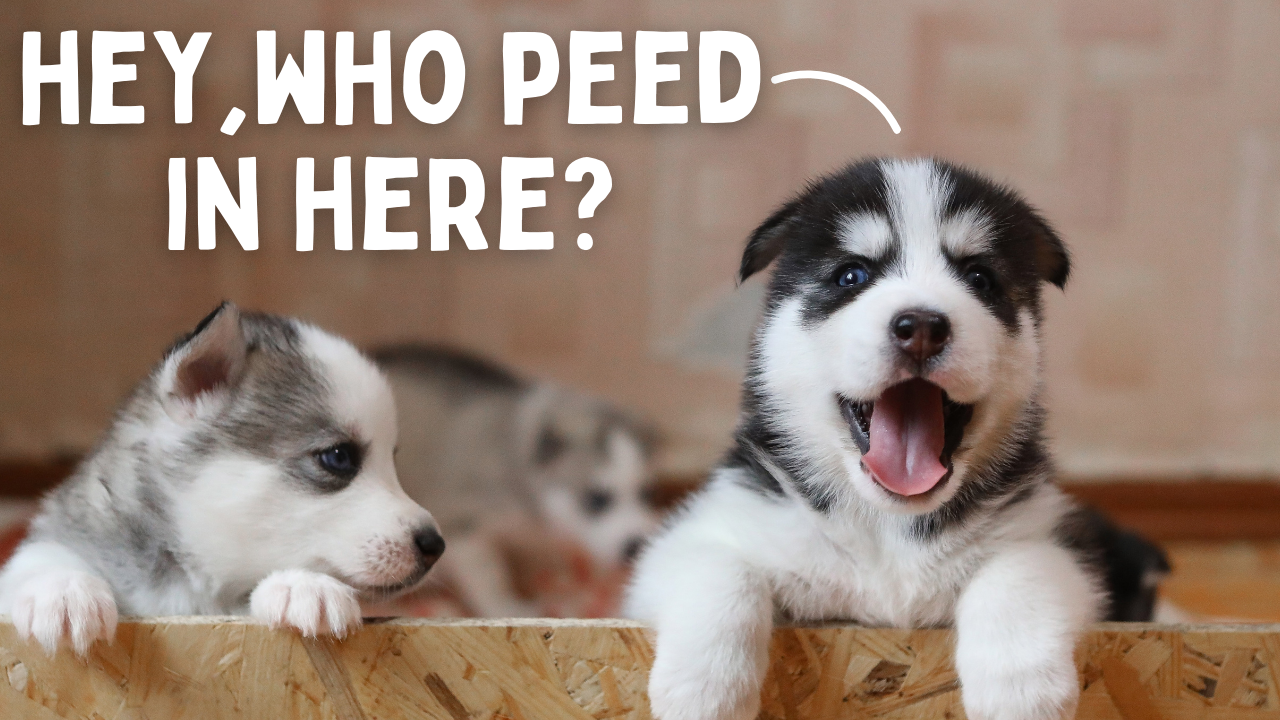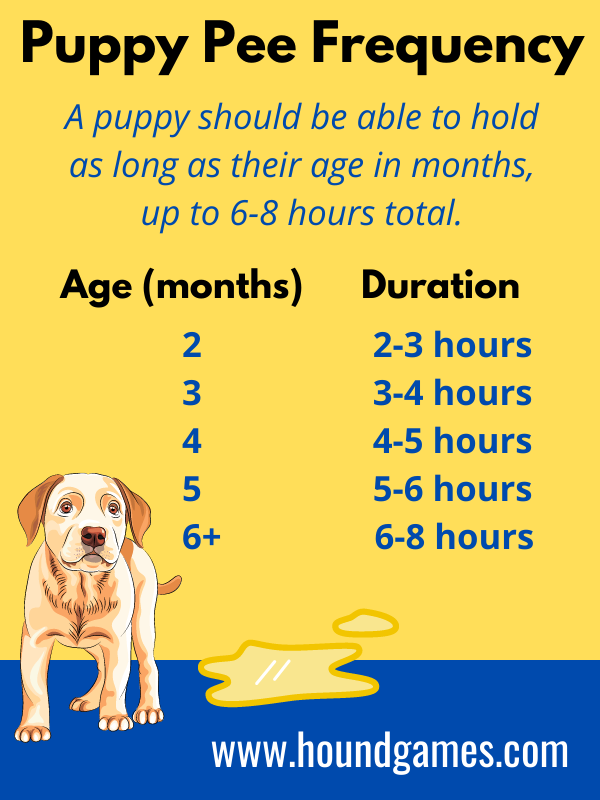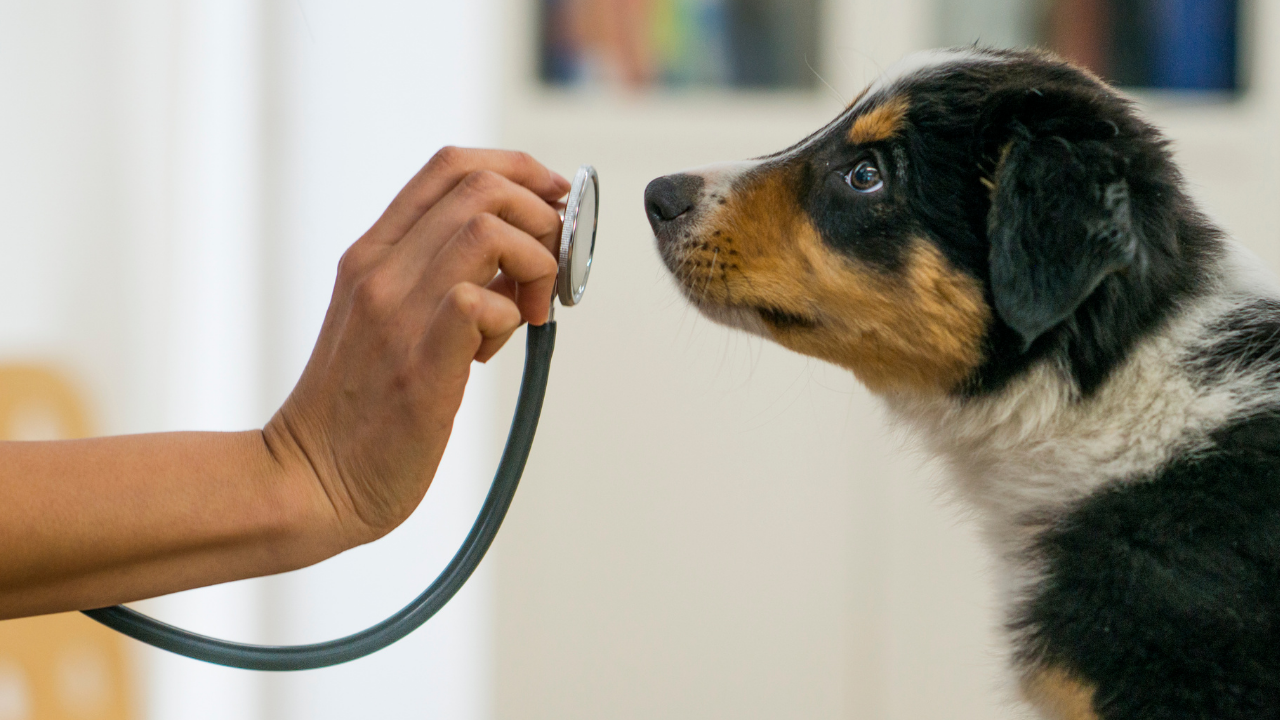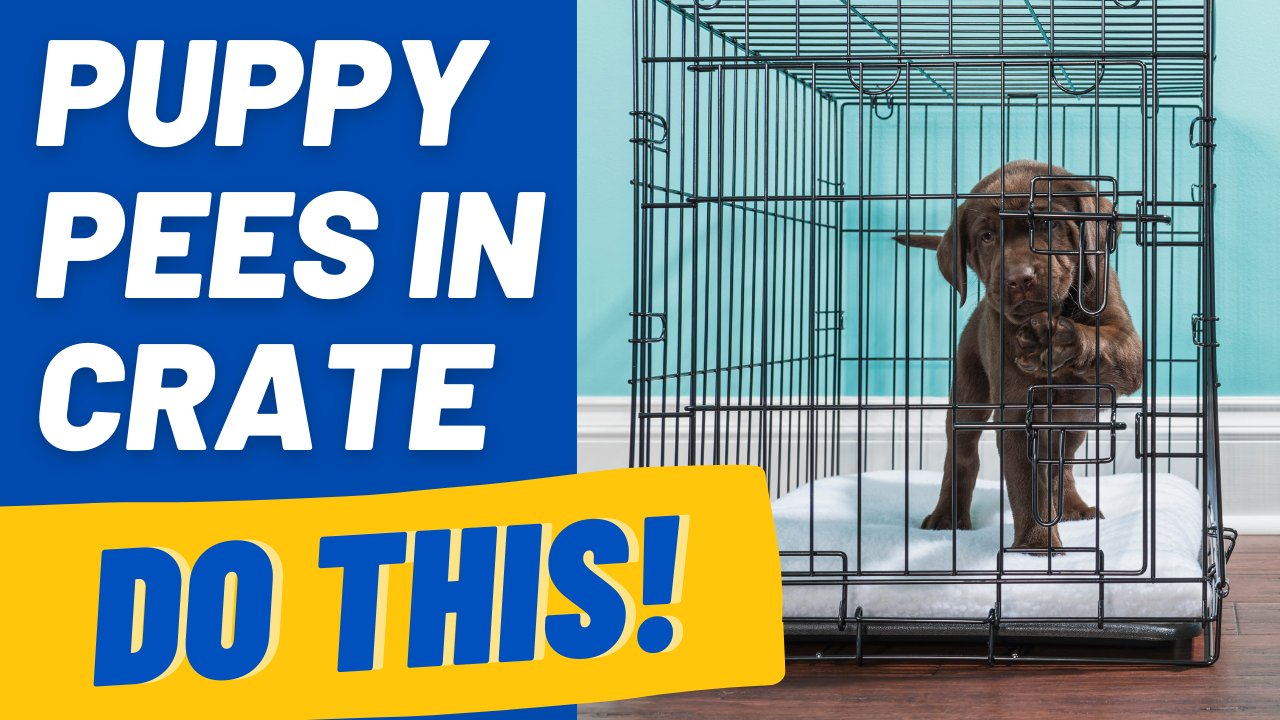Crate training is a highly recommended method to help potty train your puppy. A confined space for your puppy, such as a crate, makes it less likely they’ll pee. But what should you do if your puppy pees in their crate? And what about at night-time?
Most dogs don’t want to urinate or defecate in the same place they spend their time or sleep. However, sometimes accidents happen and this can create a pattern of behavior.
Rather than coming home to find a puppy ready for snuggles, you find a puppy that now needs a bath and a crate that needs cleaning!
Luckily, a puppy that pees in a crate doesn’t have to be a problem for long, as there are solutions.

Why is my puppy peeing in their crate?
Puppies may be peeing in their crate for several reasons. These include not enough toilet breaks, the crate is too large, the puppy was raised in an unclean environment, or due to medical issues. Crate peeing can also become a pattern behavior once it has occurred.
By narrowing down the reason for urination, you’ll be able to tackle the problem more effectively.
Let’s address each of the reasons.
Not enough toilet breaks
Puppies can only hold their bladder on average the same number of hours as their age in months, plus one.
For example, a 3-month-old puppy can only go 3-4 hours without a bathroom break, on average.
This infographic breaks it down:

This means that if you work a job with 8-hour shifts, a young puppy won’t make this time period in their crate. And even if you came home during the day to let them out, they would still need additional potty breaks.
Some puppies may be able to go longer than a few hours overnight when they are sleeping. Others will need an overnight potty break until they are older.
Be sure to also read our post Is it Cruel to Crate a Dog at Night? (Yes or No)
A potty schedule is a good idea, and using a whiteboard can help with this. Write down the times of their toilet breaks. Then using the above infographic, ensure they have enough breaks appropriate to their bladder development.
Too much room
Another reason your puppy may be peeing in their crate is there is too much room for them.
Even if the urine ends up pooling in the crate, your puppy may still feel they have room to move to one spot to pee, and then expect to have another spot to sleep.
For puppies that pee in the crate because the crate is too big, or because they’re not let outside enough, you’ll need to modify your puppy’s environment.
You may be able to partition their crate to save you from buying a new one. If not, though, you may need to buy a more appropriate crate.
We recommend this crate for puppies.
Behavioral issues
Puppies raised in an unclean environment lose their natural desire to keep their living space clean.
This often happens with puppies from puppy mills, or other situations where they’re kept in a relatively small space and the area is not cleaned.
It’s expected that puppies make messes! Breeders, fosters, and rescues should spend time cleaning up after the puppies.
A good breeder will give them a litter box or a designated potty area to instill good potty training habits in them at a young age.
To work through this problem, read more in the How to stop puppy peeing in the crate, heading.
Medical issues such as UTI, diabetes, liver disease
Puppies may be peeing in their crate because of a medical problem.
A puppy that is hard to house train, including a puppy that pees in their crate, could have a Urinary Tract Infection or a Congenital Urinary Tract.
Other potential health concerns can include diabetes or liver disease.
If your house-trained puppy is suddenly peeing inside their crate or your house, they may have a medical issue.
If your puppy is peeing on the furniture, you might like to read our post How to Stop Your Dog Peeing on the Furniture.

How to stop puppy peeing in the crate
Pre step one: it’s important to remember to stay patient with your pup during this time. It’s easy to get frustrated and even angry with a pup who keeps peeing in their crate, kennel, or house for that matter.
And especially if it’s in the middle of the night!
Yelling, growling, or rubbing a new pup’s nose in their pee will cause anxiety issues, and only exacerbate the problem.
A dog who associates an angry owner with their peeing will cause a dog who learns to hide their peeing. Meaning you might find bad odors in unusual places!
Now for the steps to stopping a pup peeing in their crate or kennel:
Step One
First, eliminate any health concerns your puppy may have. If your puppy has blood in their urine, urinates frequently in small amounts, or has foul-smelling urine, take your puppy to the vet.
Once medical problems are treated or ruled out, behavior modification plans can then begin.
Step Two
Ensure your dog’s crate size is appropriate. As very young puppies are small, you may have a crate that allows them too much room to have their own toilet corner.
Having a smaller crate, or partitioned area, can stop your puppy from peeing in their crate or kennel.
You can get partitioning dividers so you can reduce the allowable area. Such as this one.
Crates should have enough space for your puppy to stand up fully, turn around, and lay down comfortably.
You do not need to give your puppy a large crate with room for a bed, bowls, and separate sections.
If you want your puppy to have more space, then a puppy pen is a good idea separately from their crate.
Step Three
Let your puppy out more frequently, as this is the prime suspect for dogs peeing in their crate.
If you’re not able to do this, because of work or other reasons, try and find someone to let your puppy out during the day.
There are also pet services, such as dog walkers and dog trainers, who can spend time with your dog during your workday.
If you do have to leave your puppy alone through the day, we have this article for you on the subject.
If you aren’t able to increase the frequency of potty breaks during the day, you’ll need to change the setup for your puppy.
I would suggest using a playpen like this one here or a small puppy-proofed room to create a puppy-safe space.
If you’re using a puppy pen, place it on a floor that’s easy to clean. You can attach the crate to the pen if you want, giving them the option to go in the open door and settle in their crate.
The pen should have several sections for your puppy when you are unable to keep a close eye on them.
Here are the essentials for a good pen setup:
- Food and water bowls
- A place for sleeping
- A place for using the bathroom
- A space to play
You can use a litter box, puppy pads, or a potty section of fake grass for the space to use the bathroom.
This option is the ideal way to handle a puppy that may need to go to the bathroom more frequently than you can allow.
Without an appropriate place to use the bathroom, your pup may continue peeing in their crate since there is no other option.
Using a whiteboard to remind yourself of your puppy’s pee schedules can help with regular trips outside. An alarm could work also.
The more young puppies pee inside, the more they’ll keep doing it!
If you feel your puppy should be house-trained already, then be sure to read our post Puppy is Still Not House-trained: Age Expectations.
Step Four
Clean all accidents in your dog’s crate or kennel, including washing blankets and bedding.
Remove any toys from in their crate that were peed on.
Even if you can’t smell it anymore, it’s likely your puppy can, and this smell can trigger their urge to pee.
We recommend using an enzymatic cleaner such as this one here.
Summary of steps
- Check your puppy’s health
- Provide adequate breaks
- Keep the crate super clean
- Ensure it’s not too big
- Continue to be vigilant in taking your pup outside for pee breaks.
Successful house training requires a consistent effort to ensure your puppy goes outside as often as possible.
Puppy peeing in crate at night
If your puppy is peeing in the crate overnight, and not during the day, it’s likely because it is too long for your puppy to go without a potty break. Some young puppies cannot go 8-hours overnight until they are closer to 6 months old or more.
This means you might need to do a middle-of-the-night potty break service for your pooch!
Take a look at your puppy’s schedule. While I prefer to keep some variability in my puppy’s schedule so they can handle changes in the future, some general rules apply.
My puppies always have access to clean, fresh water throughout the day.
Otherwise, your puppy can develop an obsession with water, or suffer dehydration and other medical problems.
There is a possibility your puppy is having too much water, too, and we address this in our post on how much water you should give your dog.
However, if I have a new puppy that is having frequent accidents overnight, I may pick up the water bowl an hour before bed.
Puppies should also go out for a final potty break the last thing before bed, and first thing in the morning.
I have had puppies that can sleep through the night at 10-weeks of age. However, our final potty break was anywhere from 10 pm to 12 am, and we were usually up at 6 or 7 in the morning.
If your sleep routine doesn’t match how long your puppy can hold their bladder, you’ll need to set an alarm and get up in the night with your puppy.
Ideally, your puppy will whine and fuss to let you know they need to go out.
If your puppy is not doing this, I recommend starting with an alarm in the middle of the night. Then gradually move your alarm time closer and closer to your normal morning wake-up time.
Should you put a pee pad in the crate?
Putting a pee pad in the crate will not solve most peeing in the crate problems. Instead, your puppy may chew the pee pad or make the area more attractive to your puppy, as most dogs prefer to pee on soft, porous surfaces.
Training your dog to use a pee pad, litter box, or another indoor potty option, still requires you to teach them where to use the bathroom.
Rather, I encourage you to consider a pen setup as discussed above. This gives your pup separate spaces for them to sleep, use the bathroom, eat, and play.
This way, your puppy will learn there are appropriate separate areas.
Putting a pee pad in the crate will not solve the problem, and instead could lead to a puppy that continues to find the crate an appropriate place to pee.
Unless this is your goal, you should try another solution.
Will my puppy grow out of peeing in their crate?
Puppies gain more bladder control as they age, with full bladder control by about 6-months of age. So, if your puppy is peeing in their crate because they cannot physically hold it that long, they may stop as they grow older.
However, it’s not a recommended plan to wait-and-see, because you can create a puppy that thinks the crate is an appropriate potty place.
You don’t need to stress that the occasional accident in the crate as a young puppy will equal a long-term problem.
My last young puppy had 3 or 4 accidents in the crate that I can remember when he was under 6 months old, and I simply adjusted how long he went without a break.
I also removed the blanket to make it a less appealing place to pee, and made sure he had a toilet break right before going back in the crate.
More frequent accidents shouldn’t be ignored. Instead, you’ll need to consider a veterinary visit to rule out medical problems, and then make adjustments to your potty training plan.
If you’re still finding toilet training isn’t working, then consulting with a dog training professional is a good idea.
Summary
Crate training a puppy is an excellent way to give your dog a sense of security. It also provides a place for a young puppy away from under people’s feet.
So don’t do away with crate training if you’re having issues with them peeing in their crate or kennel just yet. It can just sometimes take a little time for them to understand where the appropriate place is to pee.
If you think your puppy doesn’t like their crate, then be sure to read our post Puppy Doesn’t Like Crate: (Why and What to do)




